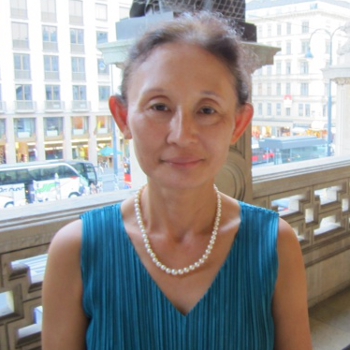On a perfect summer evening, Caramoor Opera presented a performance of Poulenc’s Dialogues des carmélites that made a strong case for opera in concert instead of elaborate and expensive production. With a group of strong soloists supported by the Orchestra of St Luke’s under the exceptional leadership of conductor Will Crutchfield, the stark music drama based on the true story of 16 nuns executed (just as the poet Andrea Chénier) towards the end of the reign of terror during the French Revolution came alive and swept the audience to its shattering finale.
It was a stroke of genius to separate the orchestra and the singers clearly on stage for this performance. The orchestra, along with the conductor, was placed in the back, and a low partition was set up across the stage to mark clearly the dividing line. The singers were free to move around and interact in the foreground, and their subtle glances and gestures often spoke volumes. Minimal costuming was also helpful. The nuns wore long black dresses and habits; the priest was dressed as such. Blanche’s father and brother, aristocrats, wore a tuxedo. Revolutionary guards and citizens wore street clothes with period references such as hats. The singers were conducted by an assistant conductor who was positioned in front of the stage but at the audience level so as not to interfere with the performance.
Poulenc reported said he could not write atonal music that was all the rage during much of his lifetime, and instead dedicated the opera’s score to Debussy, Monteverdi, Mussorgsky and Verdi. Whatever the composer might have thought was his debt to his predecessors, the musical language of the opera is unique and distinct. The opera begins with a quick pounding theme that recurs throughout and most clearly at the end, more slowly, as the sound of a guillotine as the nuns walk off-stage one by one to their deaths. The music is almost continuous from one scene to the next, with no distinct arias or set pieces, and the story centers upon a fictional character, the young and fearful Blanche, and her transformation into a martyr with her sisters unfolds seamlessly. One detected more melodious and lyrical passages reserved for the women of the convent while those outside the religious order were often given more conventional music. These details and nuances were beautifully brought out under Mr Crutchfield’s capable hands.
Two veteran singers were pillars of the performance. Deborah Polaski completely stole the first act as the old Prioress. Her voice still retains a rich and creamy tone and she sang the part of an elderly woman dying a painful death with unusual elegance and grace. Her understated singing was more effective in conveying the cruelty of fate than loud screaming and shouting to which others who essayed the role often resorted.
The second and third acts were dominated by Hei-Kyung Hong’s new Prioress. Her quiet presence on stage was a focal point even when she was not singing, and her every gesture was carefully considered for maximum effect. Vocally, her beautiful and clear soprano rang out without strain to fill the hall to express her dignified authority as the leader as well as her sympathy towards those in her charge.
Another veteran, Jennifer Larmore, sang Mother Marie with passion and energy. Her strong and piercing mezzo provided a contrasting color to the two sopranos who portrayed Mother Marie’s superiors. Jennifer Check made a good impression with her role debut as Blanche. Her high notes sometimes turned strident as she forced the volume but quieter passages were sung with subtlety and charm.
Among the secondary roles, Alisa Jordheim was a standout as Sister Constance with her sweet and expressive soprano. Her scenes with Blanche and other sisters were unusually well sung and acted and she provided deft comic touches. Tenor Noah Baetge, as Blanche’s brother, fielded a brilliant and powerful voice, while bass-baritone Daniel Mobbs was a finely acted, if a little underpowered, Marquis de la Force. Scott Brunscheen sang the role of the Chaplain with a sympathetic and well articulated tone.
For all the “dialogues” and suffering that went on, the success of the opera depends on the final scene, with the 16 women singing a Salve Regina while going to their deaths, one by one. The orchestra and the singing were both heartbreaking here, with each departing woman walking off in determination and agony to stage left. With each departure, the “swish” of the guillotine's blade is clearly heard, and some in the audience visibly shuddered. Finally with Ms Check’s beautiful rendition of her own hymn from Creator Spiritus, the stage went blank with the quiet final note of the music.




